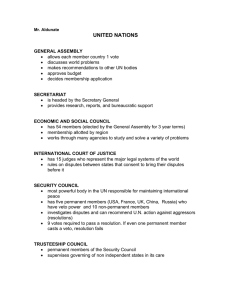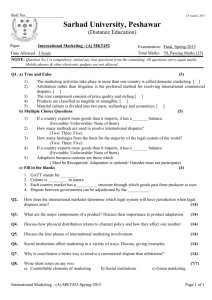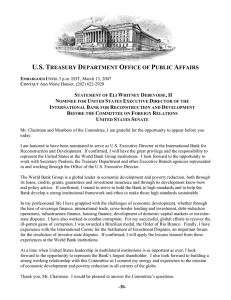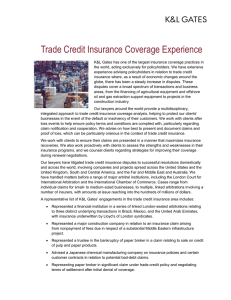The construction industry in Malaysia ... economy growth. The industry acts as catalyst for the... CHAPTER 1
advertisement
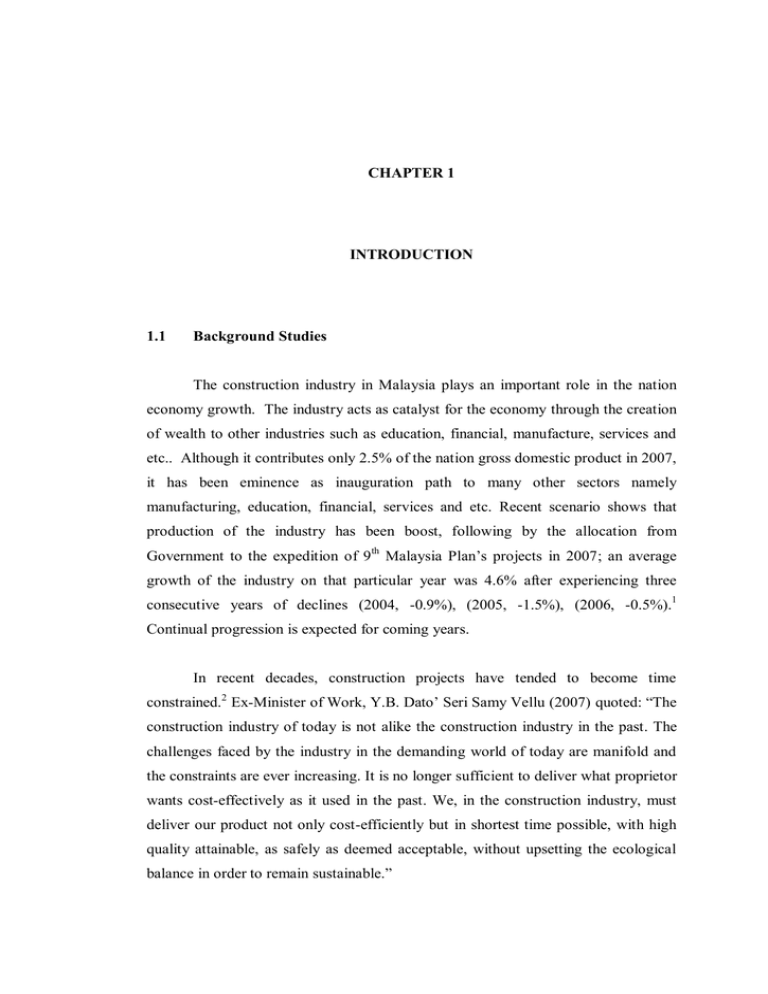
CHAPTER 1 INTRODUCTION 1.1 Background Studies The construction industry in Malaysia plays an important role in the nation economy growth. The industry acts as catalyst for the economy through the creation of wealth to other industries such as education, financial, manufacture, services and etc.. Although it contributes only 2.5% of the nation gross domestic product in 2007, it has been eminence as inauguration path to many other sectors namely manufacturing, education, financial, services and etc. Recent scenario shows that production of the industry has been boost, following by the allocation from Government to the expedition of 9th Malaysia Plan‟s projects in 2007; an average growth of the industry on that particular year was 4.6% after experiencing three consecutive years of declines (2004, -0.9%), (2005, -1.5%), (2006, -0.5%).1 Continual progression is expected for coming years. In recent decades, construction projects have tended to become time constrained.2 Ex-Minister of Work, Y.B. Dato‟ Seri Samy Vellu (2007) quoted: “The construction industry of today is not alike the construction industry in the past. The challenges faced by the industry in the demanding world of today are manifold and the constraints are ever increasing. It is no longer sufficient to deliver what proprietor wants cost-effectively as it used in the past. We, in the construction industry, must deliver our product not only cost-efficiently but in shortest time possible, with high quality attainable, as safely as deemed acceptable, without upsetting the ecological balance in order to remain sustainable.” 2 Consequences to the above, industry players have given more emphasis to the time related issues as early as during the contract binding stage. This was achieved through the employment of Forms of Contract which form the bulk of many engineering / construction contract let-out. The formation of the Form of Contract is on the basis of the agreement between the parties; and the type of the Form of Contract which commonly used in the industry are Standard Form of Contract, modified Standard Form of Contract and as hoc or „bespoke‟ Forms of Contract. Among the above, Standard Form of Contract are the most eminent in this industry. Several provisions have been drafted into the contract condition of Form of Contract which time interrelated requirements were drafted for the conduct of trade of the industry. Alike other country, Malaysia possesses quite a number of Standard Form of Contract in engineering / construction sector; PWD 203A and PAM are among the famous Form of Contracts which are widely used in the government and public sector respectively in this industry. Other than that, some are practicing Standard Form of Contract like IEM Form, CIDB Form, JCT Form, IEEE Form, FIDIC Form, ICE Form, IMechE Form, modified PWD Form, and etc for the execution of contract exercises. Whilst there are other Standard Form of Contract which involving particular industries and some specific employers, namely oil and gas, power plant, highways, TNB, PETRONAS and etc. Under the Standard Form of Contract, time frame required were specified for some particular conduct of trade which is agreed upon between parties and it were practiced over the projects; it applied either from the initial project planning stage, project execution stage and project utilization stage. Under clause 78, PWD 203A Rev. 2007, it was written that “time whenever mentioned shall be of the essence of this Agreement”, underlined the need to emphasize on „time‟. There are also numbers of clauses under both PWD 203A form and PAM form where executors are required to use their best endeavor to execute the project within the time frame and avoid the delay a project. 3 As a developing country, Malaysia construction project have been increase in size as well as complexities in its nature result from the mammoth requirement of infrastructure and advancement in technologies. Prevailing Standard Form of Contract became further ambiguities eventually make it become more complex and causing adversarial impacts especially increase in number and frequency of disputes. 1.2 Problems Statement “Time is essence” is the vital philosophy in construction industry nowadays. The issue of time scheduling has hassle the industry since the beginning. It has been acknowledged by many construction researchers and industry practitioners as one of the most important performance criteria of a successful project. When time is believed overrun beyond completion date specified in the contract or beyond the date the parties agreed upon for the delivery of one project task, time delay issue arise. The issue of time delay in the industry is not only commonly understood but accepted to be the norm. It is not just restricted as global phenomena but also no exception and is common in Malaysia‟s construction industry. The industry practitioners, proprietors and executors alike are very sensitive to changes to the agreed completion date and even time frame of its project; both want their projects delivered on time. To the proprietor, time delay denoted loss of revenue as consequential from lack of productivity. Many of proprietors would consider these extra expected losses to be wasted. From executors‟ points of view, time delay means occurring of extra overhead cost due to the longer working time as well as higher risk to the fluctuating of material and labor cost. Hence, when time-related conflicts arise; either party will try to overcome their losses by imposing claims to each other‟s. „Time is revenue‟ is closer to the reality of construction industry; with shorter time, profit margin can be increased. With regard to the fact that construction industry is also part of the business, earning more profit also mean the success of the project. To complete the projects on time and within schedule is an essential benchmark for both proprietors and executors. But there are always unexpected 4 circumstances out of both proprietor‟s and executor‟s control for the project processes slipping over its planned schedule. These processes subjected to many variables and unexpected factors, which caused by many sources such as performance and involvement by parties, resources availability, contractual relation, environmental condition. Construction project often experience delays, it can happened in whatever path along the course of contract process. The argument that arises when a construction project has been delayed is whether the proprietor or executor can recover damages from either party for the delay. Normally, when the projects are delayed, they are either extended or accelerated and therefore, incur additional cost. Even though, the normal practices usually allow a provision in the project cost as contingency allowance in the contract price,3 but in reality, those provisions are actually not sufficient when the time delay issue really took place. High on the list causes of serious construction disputes is delay and time extension. These disputes contribute to incessant increase in the number of cases pending in various courts. Approach in resolving the disputes are usually defined by the terms of the construction contract which outlines the obligations and duties of the proprietors and executors of the project. It provides the provision of remedies if one of the parties does not perform as promised. Such disputes can be very costly not only due to the high cost directly related to the disputes settlement processes such as arbitration or litigation, but can also be very costly related to the delays and possible shut down of the project while disputes are being settled. 4 Efforts from varies parties like PWD, PAM, IEM, CIDB and even Federal government on the establishing of rules and standards on works execution to encounter the delay issue can be seen from the introduction of various Standard Form of Contract and also with the existence of Contract Act 1950. There are clauses provided in Standard Form of Contract such as PWD 203A form, PAM form, and etc. as well as Contract Art 1950 in relation to time factor which attempted to evade the occurrence of disputes. 5 With the increasing complexity in contracts, the situation is expected to further worsen; numbers of disputes has been added to the existing un-settled cases and caused further delay to the settlement of un-going disputes. Involved parties will felt frustrated because of the delay in the dispute settlement which are actually time consuming. Those delays in dispute settlement have manifold effects as below: - It contributes to the cost and time overruns; - It jeopardizes the project progress if the dispute arise during course of construction; and - It is detrimental to the relationship between executors and proprietors. In disputes settlement, the involved parties will most probably try to look for more convenient method to overcome the above-mentioned effects. Many of disputes resolution methods are available and it is depend on what extend the parties can accept the method and how they need those disputes to be resolved. Among those available, litigation proceeding are well known to be the most time and cost consuming disputes resolution method. But there is still growing tendency to the disputed parties to take the dispute the court. What are the factors that bring them come to this extend? 1.3 Aim of Project This aim of study is to investigate the origin of disputes settlement that contributed by delay in project undertaking and how litigation deals with the issue in selected cases. Through this study, the parties to the contracts in construction industry may able to have better understanding on concept and their legal positions in a delay disputes settlement especially through the process of litigation proceeding. 6 1.4 Objectives of Project The above aim of research is supported with the following objectives: i. To study the taxonomy of delay and the available dispute resolution techniques in construction projects; ii. To analyze the trend of delay dispute resolution by litigation in the selected cases, and iii. 1.5 To formulate an outline for better delay dispute avoidance. Scope of Study Scope of this study covers on the delay disputes related issue and cases in Malaysia construction industry and it is attempted to link with Standard Form of Contract. The reference of Standard Form of Contract will be concentrated on PWD 203A (83)/2007 and PAM 1998/2006 (with quantities) which are well known and commonly used standard form of contract in Malaysia. All cases attended to in this study are representing disputes that are resorting to litigation rather than arbitration or other alternative dispute resolution; although the use of mediation which is one of the alternative disputes resolution method to resolve commercial disputes can be said to be the continuing international trend (Oon Chee Kheng, 2006), however, this study is not going to debate on that area. 1.6 Brief Project Methodology The methodologies of this study has been separated into few steps, namely identifying the research issue, literature review, data collection, research analysis, and conclusion and recommendation. This approach is to ensure that the collection of the information and the data analyzing can be precisely implemented. 7 1.6.1 Initial Study and Identifying the Research Issue The overview of concept for the study was obtained through initial intensive reading of books, journals, articles and newspaper cutting which can easily be attained from the National Library, The Institution of Engineers, Malaysia‟s Library and UTM‟s Library. Related information concerning current scenario of construction industry in Malaysia and the contract issues in the industry were referred. From the research issue, the objectives of the study are identified. 1.6.2 Literature Review Various documentation and literature review regarding to the time delay in construction related issue are collected to achieve the research objectives. Books, journals, research papers, reports, newspaper as well as sources from the internet are referred. References were obtained from libraries in The Institution of Engineers, Malaysia, Selangor Branch, and Nation Library, Kuala Lumpur. 1.6.3 Data Collection Legal cases based on previous court cases, journals, papers, reports which are related to the time delay disputes in construction industry are collected from Malayan Law Journals via UTM library collection and electronic database. Primary data: electronic database, secondary data: books, act, articles, seminar papers and etc. 1.6.4 Research Analysis Once the data are collected, case study is conducted on the related legal cases. All the fact of the cases are reviewed and clarified. The focus of the analysis is on disputes associated with the time delay in construction which is referred to the court 8 and the consequences of time delay disputes towards the parties involved in the contract. Further to this, discussion and comparison would be done. The most frequent disputes associated with the time delay in construction which are referred to the court author are compared and identified. The same also would be done for the consequences of the time delay disputes toward the parties involved. 1.6.5 Conclusion and Recommendations Conclusion and recommendations are made based on the findings during the stage of analysis.
